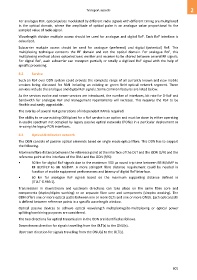Page 611 - 5G Basics - Core Network Aspects
P. 611
Transport aspects 2
For analogue RoF, optical pulses modulated by different radio signals with different timing are multiplexed
in the optical domain, where the amplitude of optical pulse is an analogue value proportional to the
sampled value of radio signal.
Wavelength division multiple access should be used for analogue and digital RoF. Each RoF interface is
colourized.
Subcarrier multiple access should be used for analogue (preferred) and digital (potential) RoF. This
multiplexing technique concerns the RF domain and not the optical domain. For analogue RoF, this
multiplexing method allows optoelectronic emitter and receiver to be shared between several RF signals.
For digital RoF, each subcarrier can transport partially or totally a digitized RoF signal with the help of
specific processing.
8.2 Service
Such an RoF over ODN system could provide the complete range of all currently known and new mobile
services being discussed for RAN including an existing or green field optical network segment. These
services include the analogue and digital RoF signals. Some common features are listed below:
As the services evolve and newer services are introduced, the number of interfaces, bit rate for D-RoF and
bandwidth for analogue RoF and management requirements will increase. This requires the RoF to be
flexible and easily upgradable.
The overlay of several RoF generations of independent RAN is required.
The ability to re-use existing ODN plant for a RoF service is an option and must be done by either operating
in usable spectrum not occupied by legacy passive optical networks (PONs) in a particular deployment or
re-using the legacy PON interfaces.
8.3 Optical distribution network
The ODN consists of passive optical elements based on single mode optical fibre. This ODN has to support
the following.
Maximum fibre distance between the reference point at the interface of the OLT and the ODN (S/R) and the
reference point at the interface of the ONU and the ODN (R/S):
• 50 km for digital RoF signals due to the maximum 500 µs round trip time between BB M/dMP to
RF BEP/FEP to BB M/dMP. A more stringent fibre distance requirement could be needed in
function of mobile equipment performances and latency of digital RoF interface.
• 60 km for analogue RoF signals based on the maximum supporting distance defined in
[ITU-T G.989.1].
Transmission in downstream and upstream directions can take place on the same fibre core and
components (duplex/diplex working) or on separate fibre core and components (simplex working). The
ODN offers one or more optical paths between one or more OLTs and one or more ONUs. Each optical path
is defined between reference points in a specific wavelength window.
Optical passive devices to achieve optical wavelength multiplexing/de-multiplexing or optical power
splitting/combining purposes are considered.
The two directions for optical transmission in the ODN are identified as follows.
Downstream direction for signals travelling from the OLT(s) to the ONU(s).
Upstream direction for signals travelling from the ONU(s) to the OLT(s).
601

